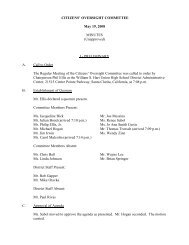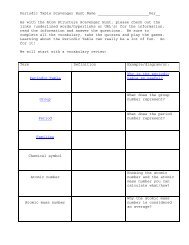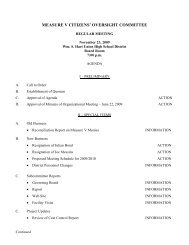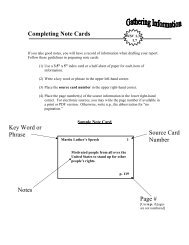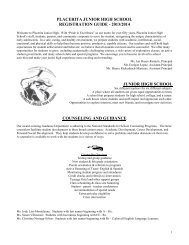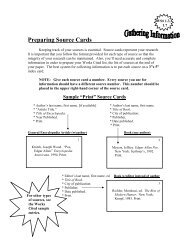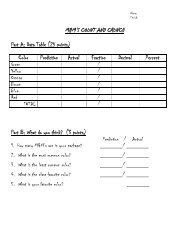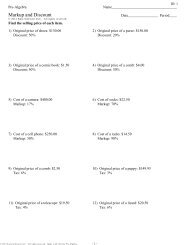Safe School Plan - William S. Hart Union High School District
Safe School Plan - William S. Hart Union High School District
Safe School Plan - William S. Hart Union High School District
Create successful ePaper yourself
Turn your PDF publications into a flip-book with our unique Google optimized e-Paper software.
Air cleaners: Air cleaners can be effective at reducing indoor particulate levels, provided the specific cleaner is adequately matched to the<br />
indoor environment in which it is placed. However, they tend to be expensive. Air cleaners can be either a portable unit to clean a single room<br />
($50 - $300) or a larger central air cleaner to clean the whole house ($300 - $1000+). Most air cleaners are not effective at removing gases<br />
and odors. The two basic types of air cleaners for particle removal are:<br />
Mechanical cleaners, which contain a fiber or fabric filter. The filters need to be sealed tightly in their holders, and cleaned or<br />
<br />
replaced regularly.<br />
Electronic air cleaners, such as electrostatic precipitators (ESP) and ionizers. ESPs use a small electrical charge to collect particles<br />
from air pulled through the device. Ionizers, or negative ion generators, cause particles to stick to materials (such as carpet and<br />
walls) near the device. Electronic air cleaners usually produce small amounts of ozone as a byproduct.<br />
The effectiveness of an air cleaner is usually reported in terms of efficiency, which can be misleading, as it only tells half of the story. The<br />
other important factor is air flow. Together, these two factors equal the Clean Air Delivery Rate (CADR), which is a better measure of how a<br />
device will actually perform. For example, 99.99% efficiency sounds great, if the flow is only 20 cfm, one would be better off at 90%<br />
efficiency and 100 cfm (CADR: 20 vs 90 cfm).<br />
Room units should be sized to supply at least two or three times the room volume per hour. Most portable units will state on the package the<br />
unit’s air flow rate, the size room it cleans and perhaps its particle removal efficiency and its CADR. Central system air units should handle at<br />
least 0.5 air changes per hour, the air exchange rate necessary to reasonably ventilate a house continuously under most conditions.<br />
For central air conditioning systems, electrostatic precipitators, high efficiency media filters and medium-efficiency media filters can be<br />
added so that the particle level in the indoor air can be kept within acceptable levels during a prolonged smoke event. However, these filters<br />
create more air resistance in the system, and may not be able to be used without modifications to the system.<br />
Devices that remove gases and odors are relatively costly, both to purchase and maintain. They force air through materials such as activated<br />
charcoal or alumina coated with potassium permanganate. However, the filtering medium can become quickly overloaded and may need to be<br />
replaced often. Some devices, known as ozone generators, personal ozone devices, “energized oxygen” generators, and “pure air” generators,<br />
are sold as air cleaners, but they probably do more harm than good. These devices intentionally produce ozone gas to react with pollutants in<br />
the air. Ozone is composed of three atoms of oxygen. The third atom can detach from the molecule and reattach to molecules of other<br />
substances, thereby altering their chemical composition. It is this ability to react with other substances that forms the basis of manufacturer’s<br />
claims. However, the EPA has found that ozone is generally ineffective in controlling indoor air pollution at concentrations that do not<br />
greatly exceed public health standards. In addition, ozone does not remove particles from the air, so would not be effective during smoke<br />
events. (Some ozone generators include an ion generator to remove particles, but it would be far safer to buy the ionizer by itself.) Ozone,<br />
whether in its pure form or mixed with other chemicals, can be harmful to health. When inhaled, ozone can damage the lungs. Relatively low<br />
amounts of ozone can cause chest pain, coughing, shortness of breath and throat irritation. It may also worsen chronic respiratory diseases<br />
such as asthma, as well as compromise the body’s ability to fight respiratory infections. As a result, using an ozone generator during a smoke<br />
event may actually increase the adverse health effects from the smoke. For more information about ozone generators that are sold as air<br />
cleaners, see www.epa.gov/iaq/pubs/ozonegen.html.<br />
Humidifiers are not technically air cleaners, and will not significantly reduce the amount of particulate in the air during a smoke event. Nor<br />
will they remove gases like carbon monoxide. However, humidifiers and dehumidifiers (depending on the environment) may slightly reduce<br />
pollutants through condensation, absorption and other mechanisms. The greater benefit of running a humidifier in an arid environment during<br />
a smoke event would be to reduce stress on the respiratory system, by keeping the mucus membranes moist.<br />
For more information about residential air cleaners, see www.epa.gov/iaq/pubs/residair.html.<br />
In vehicles: Individuals can reduce the amount of particulate in their vehicles by keeping the windows closed. However, cars heat up very<br />
quickly in warm weather, and heat stress can be an issue. Children and pets should never be left in a vehicle with the windows closed. The<br />
car’s ventilation systems typically remove a portion of the particulate coming in from outside. For best results, most cars have the ability to<br />
re-circulate the inside air, which will help keep the particulate levels lower.<br />
Reduced activity: Reduction of physical activity reduces the dose of inhaled air pollutants, and may reduce the risk of health impacts during<br />
a smoke event. During exercise, people may increase their air intake as much as ten times their resting level. An endurance athlete can<br />
process as much as twenty times the normal intake. This brings more pollution deep into the lungs. While exercising, people tend to breathe<br />
through their mouths, bypassing the natural filtering ability of the nasal passages: again, delivering more pollution to the lungs. They also<br />
tend to breathe more deeply, causing the particulate to lodge deeper into the lungs where it can cause more damage.<br />
Other sources of air pollution: Many indoor sources of air pollution can emit large amounts of the same pollutants present in forest fire<br />
smoke. Indoor sources such as cigarette smoke, gas, propane and wood burning stoves and furnaces, and activities such as cooking, burning<br />
candles and incense, and vacuuming can greatly increase the particulate levels in a home. Some of these sources can also increase the levels<br />
of polycyclic aromatic hydrocarbons (PAHs), carbon monoxide and nitrogen oxides. Besides cigarette smoke, combustion sources that do not<br />
vent to the outdoors contribute<br />
69





